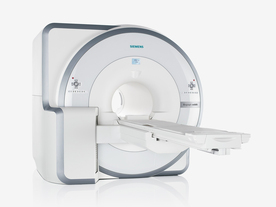 | Info
Sheets |
| | | | | | | | | | | | | | | | | | | | | | | | |
 | Out-
side |
| | | | |
|
| | | | | |  |
|  |  |
 |
| |
| Imaging with two different methods - fluorescence and MRI. Molecular imaging agents may be useful in bimodal imaging. | |  | |
• View the DATABASE results for 'Bimodal Imaging' (4).
| | | | |  Further Reading: Further Reading: | Basics:
|
|
| | |  |
 |
| |
| A sequence of two or more pulses with a null response at a particular frequency used to suppress the water signal in localized proton spectroscopy. | |  | |
• View the DATABASE results for 'Binomial Pulses' (2).
| | | | | |  | |  |  |
 |
| |
|

FDA cleared and CE Mark 2011.
The Biograph mMR has a fully-integrated design for simultaneous PET/MRI imaging. The dedicated hardware includes solid-state, avalanche photodiode PET detector and adapted, PET-compatible MR coils.
The possibility of truly simultaneous operation allows the acquisition of several magnetic resonance imaging ( MRI) sequences during the positron emission tomography (PET) scan, without increasing the examination time.
See also Hybrid Imaging.
Device Information and Specification
CLINICAL APPLICATION
Whole Body
CONFIGURATION
Simultaneous PET/MRI
26 cm (typical overlap 23%)
A-P 45, R-L 50, H-F 50 cm
PET RING DIAMETER
65.6 cm
PATIENT SCAN RANGE
199 cm
HORIZONTAL SPEED
200 mmsec
PET DETECTOR
Solid state, 4032 avalanche photo diodes
DETECTOR SCINTILLATION MATERIAL
LSO, 28672 crystals
CRYSTAL SIZE
4 x 4 x 20 mm
DIMENSION H*W*D (gantry included)
335 x 230 x 242 cm (finshed covers)
COOLING SYSTEM
PET system: water; MRI system: water
Aautomatic, patient specific shim; active shim 3 linear and 5 non-linear channels (seond order)
POWER REQUIREMENTS
380 / 400 / 420 / 440 / 460 / 480 V, 3-phase + ground; Total system 110kW
| |  | | | |  Further Reading: Further Reading: | | Basics:
|
|
News & More:
| |
| | |  |
 |
| |
|
MRI guided biopsies are usually performed for lesions that are found on for example liver or breast MRI procedures and that are not seen on computed tomography, ultrasonography or mammography. The identification of cancer on breast MRI is dependent on uptake of intravenous contrast agents.
First an MRI scan, using a dedicated breast coil and biopsy guidance system is performed to found the lesion. After skin disinfection and local anesthesia, the biopsy procedure starts. Possible MR guided interventions include fine needle aspiration, core needle biopsy and vacuum-assisted biopsy (VABB) to sample tissue from the lesion; or wire localization prior to surgery for lesions that are not palpable.
See also Breast MRI.
| |  | |
• View the NEWS results for 'Biopsy' (6).
| | |
• View the DATABASE results for 'Biopsy' (10).
| | | | |  Further Reading: Further Reading: | | Basics:
|
|
News & More:
| |
| | |  |
 |
| |
| | | | | |  | |
• View the DATABASE results for 'Bipolar Gradient Pulse' (7).
| | | | | |  | |  |  |
| | |
|
| |
 | Look
Ups |
| |